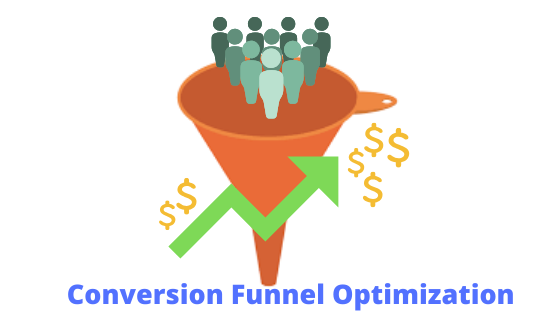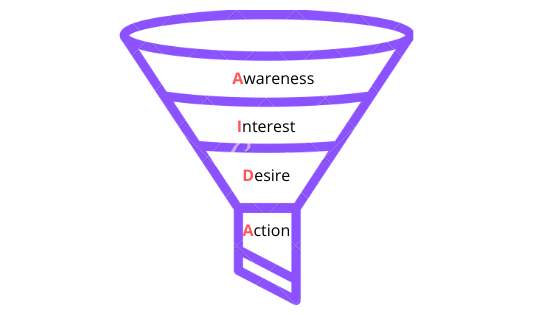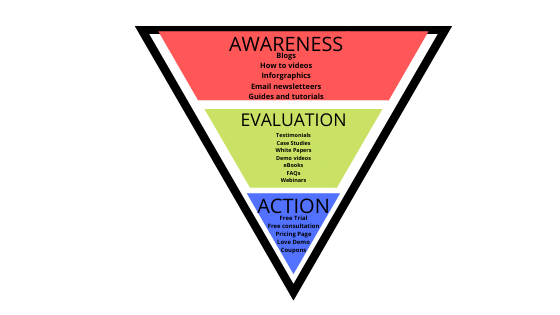Conversions Funnel Optimization- What and How

The goal of any business website is to attract potential customers, give them information about your products or services and finally the main part, make them your loyal customers. The whole process of attracting potential customers to finally making them buyers or your customers is, in fact, a long journey most of the time. Business owners and marketers usually have a lot of work to do to get their websites to function in the most expected way and your visitors complete the desired action. The whole process is referred to as website conversion optimization. For analyzing your website conversions and in order to optimize it effectively, one of the most helpful ways is to develop a strong marketing conversion funnel. This blog tells you all about what a conversions funnel is and how to optimize it.
A conversion funnel basically is a way to visualize the flow and conversion of your visitors (potential customers) into actual customers. The visitors may be generated from any of your marketing tactics- inbound or outbound - SEO, content marketing, social media marketing, pay per click ads, email marketing or even cold outreach.
Just as a normal funnel guides the liquid into the bottles or containers, a marketing conversion funnel guides your target customers to become actual customers. There are essentially 4 basic steps in the marketing conversion funnel process which is usually called AIDA:

- Awareness- Your potential customers have to become aware of your product. For this, you actually need to reach out to your target groups through various channels like social media marketing, PPC campaigns, Search engines, etc.
- Building Interest- Once the potential customers are aware of your products, the next step is to build interest in them about your product. You can use your website and content for this. Understanding what users are looking for and creating content that addresses their needs are a great way to make them interested in what you offer and improve your brand recognition. Blogs and any other helpful resources or content that help your audience understand what exactly you are offering can bring them closer to you.
- Desire- Now, the interest should become strong enough that they actually desire your product. They have to be convinced about why they need your product or service. This can be achieved when you continuously build interest and relationship between you and your potential customers. An email series or drip campaigns are great for this. Highlight what problems you solve for them, and how your product is different from others.
- Action- The last step of the conversion funnel- the big action that you want your customers to take, it may be buying a product or even simple as subscribing to a newsletter. Only a very small percentage of users who entered the funnel will make it to this level.
Conversion funnel optimization is the process of taking steps to improve your funnel, by improving the number of users that moves from each step of the funnel to the next level and drive them towards the final level of taking action. Thus, conversion rate optimization can be done at every stage in the funnel by thinking about the user experience at each stage- what your users want and how you can satisfy them.
For maximizing your conversion funnels you would have to do a lot of experimentation, dig into analytics and optimize your design and content.
Optimizing Conversion Funnels
Optimizing your conversion funnels can be daunting, but if you focus on certain points it and approach it more systematically, it can make a lot of difference. Optimizing your conversion funnel can be considered to be an evolutionary improvement, that can be achieved by continuous testing, implementations, and measuring your marketing strategies related to different parts of the funnel. It certainly would take considerable time to get closer to the best alternative and achieve your goals. You should aim for measurable goals and then address each stage in the funnel to move towards your set goals.
So, now how do you go about optimizing your conversion funnel? Here is a step by step approach for optimizing your conversions funnels.
- Create your conversion funnels
You can create conversion funnels in Google Analytics by setting up Goals and use them to analyze your funnels. Browsee offers you a more straight forward way to create funnels. You just need to add the steps for any particular funnel and name the funnel.
Creating conversion funnels in Browsee lets you understand how users visiting your website navigate through the steps and where they get dropped exactly.
- Create content on your site to drive visitors from one level to the next level in the funnel.
Your website content should be crafted such that it entices your visitors and encourage them to move ahead through the next levels of your funnel. You have to ensure that you develop content for each stage of the funnel.

Your AIDA funnel can be considered to have three parts- the top part (Awareness), the middle part comprising the Interest and Desire stages(Evaluation) and the Bottom part(Action).
Top of the funnel content should focus more on creating awareness of your brand, product, services, etc and include more helpful information relevant to your target audience to gain their attention. The intent of the content should be education and should avoid being salesy. The content at this stage is not meant to immediately convert the visitor to customers or leads. This content can be a great way to bring new visitors to your website who could potentially become your customers.
You can even try to include content for lead generation like creating a downloadable ebook or guide, requiring users to provide their email addresses for accessing it. Many users wouldn’t hesitate to give their email address provided they feel it is a valuable resource that they are getting for free, and you get to build your email list with this simple process.
Middle of the funnel content is to convince your users and let them know what value they get from you and how your product or services are different from what others offer. At this stage, people already know about you and want to know more about your business and what you can do for them. Customer testimonials, demo videos, white papers, webinars, ebooks, FAQ pages, etc can be part of this stage.
The bottom part of the funnel, the final stage of action, should focus on pushing your users to take the big action. Offering free consultations, live demos, demos, free trials, coupons, etc can motivate them to take the big step.
3.Perform Funnel analytics and identify the leaks in the funnel
A marketing/sales funnel actually isn’t a funnel that directs all the fluid into the container. In a marketing or sales funnel there will be leaks. All the users entering the mouth of the funnel do not reach until the last stage. In fact, only a very small percentage of the users who entered the funnel come out of the opening at the end after successfully completing the desired action. This process of users getting out of your funnel is called leaks.
The latest analytics tools help you identify where these leaks occur and enable you to take corrective measures to minimize them.
How Browsee help in funnel analytics?
Browsee’s funnel analytics features help you get a clearer picture of why your users drop from your conversion funnels before reaching the goals. It enables you to analyze the dropped sessions individually to give clarity on what is not working in your funnel.
With Browsee’s funnel analytics, you will get session replays for dropped sessions, the number of users and sessions for each step, and percentage conversion and average session time for all sessions in a funnel. You can also set up funnel alerts by which you get your funnel analytics in your daily summary email from Browsee.
4. Optimize for Conversions
Once you identify the leaks and the reasons, you have to take action to fix them. This would require a lot of experimentation and testing. In fact, there are tons of changes you can test on a website to improve conversions. These changes could be anything from a call to action copy to the placement of elements on your landing page.
For effective conversion optimization, one of the key things is to know as much as you can about the actions people took on your site and how they engaged with elements on your site. These can probably give you insights on what prevented users from converting or what were the hurdles they faced in the journey through your website. The best way to get this information is by using analytics tools like heatmaps and session recordings.
Heatmaps provide a visual representation of where and which elements on your website your users focus more attention on and which areas they don’t. Whereas session recording enables you to watch your user’s journey through your website and monitor the actions they take on your website. These tools help you eliminate a lot of guesswork in formulating hypotheses for what works or what does not on your webpages. Browse helps you a step further by providing component analytics where you can analyze click through rate and time spent in any element or part of page
Based on your observations from the analytics tools, you can make changes to your pages and start testing them. Here are a few conversion funnel elements that you should be analyzing/testing for conversion optimization:
- Landing Pages- Analyze you landing page elements including headlines, copy, color, font size, page load speed, etc.
- Sign up forms- Your sign up forms are an important factor in your conversion funnel and that requires keen attention. So you need to analyze it’s headlines, text box words, placement, number of input fields in a page, captcha, etc. Most of us dnt like filling out insanely long sign up forms which takes too much time to be filled and collects un necessary information. So keep a check on length of the forms and the fields to improve conversions.
- Trust Elements- Trust elements on your website can make a lot of difference in improving conversions. Elements like Guarantee,VeriSign Logo, testimonials, etc can convince and build trust in the users and improve the conversion rate.
- Test your email conversions- Email newsletters is an important part in your conversions funnel to build and maintain a relationship with he target audience. So analze the open rates, copy, click throughs, etc of your email campaigns to improve your overall marketing funnel conversions.
- Test!Test!Test!
This probably is one of the most important things to keep doing to optimize your conversion funnel. Keep testing the conversion funnel elements to identify what works best. To get the best results, you should opt for a testing approach that combines Usability testing and A/B testing.
Usability Testing- It simply is a way to see how easy it is to use your webpage or website by testing it with real users who give feedback on the user-friendliness and issues they face while navigating through your website. Based on the feedback from usability testing, you should come up with alternative designs (preferably at least 2 or more) of your webpage.
A/B testing- In A/B testing, you split your incoming web traffic to various versions of your webpage, and determine which performs the best. If you use the alternative versions you designed based on feedback from usability testing, the A/B test results will confirm your insights from usability testing giving you much more effective results if either of them were used alone.
Conclusion
Conversion funnel optimization is challenging and something that you often fret on. But if you really try to understand what your customers need, provide them with that and excite them with your products or services, and provide a seamless experience, it can certainly help streamline your conversion funnel. Always think in terms of your audience and know that even the smallest changes can make a lot of difference in the way customers respond. Conversion rate optimization(CRO) tools like Browsee are lifesavers for who really want to get away with the guesswork and assumptions associated with conversion funnel optimization and get a clear picture of what your users want.
How much is a great User Experience worth to you?
Browsee helps you understand your user's behaviour on your site. It's the next best thing to talking to them.


